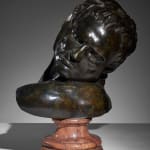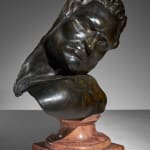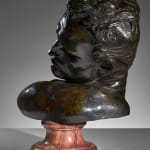Jef Lambeaux
Further images
Jef Lambeaux (1852 - 1908) was a Belgian sculptor. He was the son of a Wallonian father and a Flemish mother and brother of the painter Jules Lambeaux.
Lambeaux studied at the Royal Academy of Fine Arts in Antwerp as a pupil of Nicaise De Keyser and Joseph Geefs, but they would have little or no influence on his later work. He joined a group of young artists, led by Jan van Beers. This group also included Piet Verhaert and Alexander Struys (1852-1941). They were somewhat notorious for their eccentric behaviour, including walks in Antwerp dressed in historical costumes.
His first work "War" was exhibited in 1871. This was followed by a long series of humorous, picturesque groups, such as "Dancing Children", "The Lucky Number" and "An Accident" (1875). He then left for Paris, where he had a miserable life. Here he produced "The Beggar" and "The Kiss" (1881), considered his masterpiece. On a visit to Italy, he was strongly impressed by Giambologna's sculptures. This gave him a great liking for the effects of force and movement in the human figure.
In 1883, he became one of the founding members of the artists' circle “Les Vingt”, but he already resigned after the first Salon in 1884 due to his dissatisfaction with the group's overly avant-garde ideas.
One of the monuments realised by Lambeaux is the famous "Brabofountain" (1887) on the Grote Markt (Grand-Place) in Antwerp, inspired by the movement effects in Giambologna's work, this work has become the official symbol of the city of Antwerp. It depicts "Silvius Brabo," the legendary founder of Antwerp. On the pedestal one sees mermaids, seals and other sea creatures, depicted with a suppleness that already anticipates Art Nouveau.
He also produced a large number of sculptures such as "The Roof of the Eagle's Nest" (1890).
His "Drunkenness", shown at the Brussels Salon in 1893, earned him much criticism for its sensual depiction of human flesh. Jean Delville (1867-1953) gave him the nickname "Michelangelo of the gutter". But the following year, after its exhibition in Paris, he did receive an award from the Legion of Honour for this.
His work "Triumph of the Woman" (1901) caused great commotion from Catholic circles at the 1905 World Fair in Liège. The giant haut-relief "The Human Urges" (1889-1894), a minutely elaborated sketch exhibited in 1889, shows great sensuality and baroque panache.
The sculpture did receive initial criticism for depicting all movement, but in fact little inner feeling.
He also produced a large number of portrait busts, such as Hendrik Conscience, Henri de Braekeleer and Brussels mayor Charles Buls. His numerous other works also depict "nymphs," groups of forest gods, "bacchantes" and "centaurs". His "Nymph of the Bocq" remained stored in the cellars of Saint-Gilles town hall until 1976, due to being deemed "too indecent" in the 19th century. Now it stands on the square in front of the town hall. The work "Bitten Faun," commissioned for the Parc de la Boverie in Liège, caused another scandal. It was sent back, but broke on the way. The government provided a new one.
Lambeaux became friends with the painter Alfred Bastien and they even lived together for a while. Bastien was also the model for the statue honouring master builder Pieter Appelmans (to the right of Antwerp Cathedral), unveiled in 1935.
Towards the end of his life, his works became rather a repetition in the sense of his earlier works. He worked on his technical skill without further innovation. He had achieved success. He had received as many as 20 orders for monumental works in public spaces during his career.
He became a member of the Royal Academy of Sciences, Letters and Fine Arts. He is also named as a member of Freemasonry.
Lambeaux called himself a realist and by no means a symbolist. His marble pieces are neither poetic nor philosophical. He only wanted to eclectically depict the movement and panache of his models. This was typical of Lambeaux, though. He wanted to appeal to the eye rather than the intellect. The bronze sculpture depicting himself portrays him as a "cursed poet," which he was by no means.
Saint-Gilles had promised him a museum in 1898, if only he left enough works to the museum. But it was never built. These pieces were stored with a neighbour but were destroyed by bombing during World War II. In 2006, an association "ASBL Musée Jef Lambeaux" was formed to promote the construction of a museum for Jef Lambeaux.
Though other works by him can be found in the collections of museums in Antwerp, Brussels, Liege, Ghent, Ostend, and Bucharest.
Literature
Bénézit, E.; Pas, W. & G. - Arto 2000







